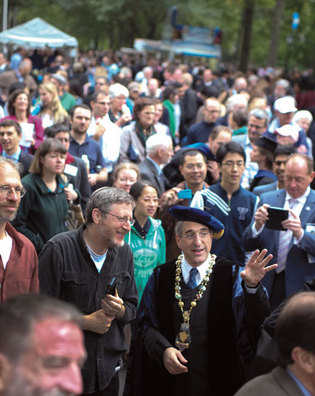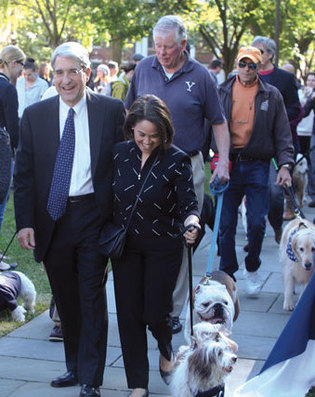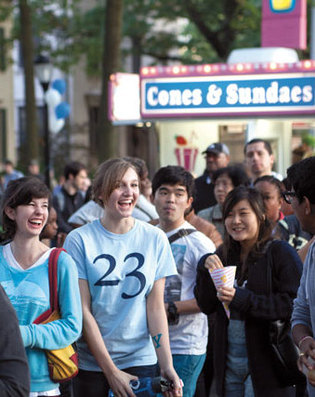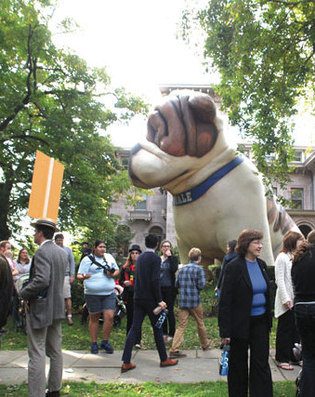 loading
loading
featuresThe populist inaugurationYale’s 23rd president didn’t celebrate his inauguration in black tie. Instead, he ordered up bite-sized, blue-frosted cupcakes, a huge, inflatable bulldog, and bluegrass. Kathrin Day Lassila ’81 is editor of the Yale Alumni Magazine. Additional reporting was provided by Minami Funakoshi ’14.  Mark OstowView full image“Because I’ve been playing bluegrass with Peter for a long time,” said Craig Harwood ’02PhD into the mike onstage in the Hall of Graduate Studies courtyard, “there’s something I know about him that you don’t know.” Harwood, mandolin player for the Professors of Bluegrass (and former dean of Davenport College) paused. Peter Salovey ’86PhD, the Professors’ bass player, smiled. Then Harwood delivered the punch line: “Peter’s actually quite an introvert! And playing bluegrass is what made him come out of his shell!” The audience laughed, and Harwood told them that Salovey would show off his new personality by singing the next song. When the tidal waves of applause died down, the president of Yale University stepped up to the mike and backed the frontman in “Dim Lights, Thick Smoke.” Halfway through the next number, Salovey laid his bass down on the floor, came up to the front of the stage, and danced an Appalachian-style flat-foot shuffle with the fiddler. The screams from the student audience could have been for the Rolling Stones. “Dim Lights, Thick Smoke” aside, Yale’s 23rd president is low-key. But if he’s an introvert, it didn’t show during the graduate and professional-school student party in the HGS courtyard. Nothing about the way Yale celebrated his inauguration said “introvert.” Salovey’s, said Margaret Marshall ’76JD, Senior Fellow of Yale’s governing board, was “the most extensive and most inclusive inauguration in Yale’s history.” Yale has seen splashy inaugurations before. Kingman Brewster Jr. ’41 had his black-tie inaugural ball in Ingalls Rink, with a huge staircase installed at one end so guests could enter in style, enjoying, as they descended, the sight of imported potted palms on the skating rink floor. But Salovey’s inauguration was a different kind of extravagant. The festivities lasted a full week, there were no black-tie events, and although some events were invitation-only, the theme Yale was striving for wasn’t elegance, but togetherness.  Mark OstowView full imageOn Monday, Salovey and his wife, Marta Moret ’84MPH, started a five-day tour of Yale’s academic and administrative departments to meet faculty and staff. On Thursday afternoon there was an all-staff, all-faculty party (a rare event at Yale) and on Friday a concert. On Saturday, Yale held a daylong town and gown “Open House”: “All are welcome,” read the posters and the front-page headline in the New Haven Register. The kickoff event: a parade of local dogs—by one estimate, about a hundred—held on Cross Campus and featuring Handsome Dan and Portia, Salovey and Moret’s Havanese, in the lead. After that came a plethora of open houses and performances. The Center for British Art offered tea for all, with harp accompaniment. Undergraduate residential colleges put on concerts. The med school, the planetarium, the residential colleges, the musical instrument collection, the student cultural centers, and more were open for visitors. On Cross Campus, a South Indian dance group, a comedy troupe, a magician, and other student performers took turns onstage throughout the day. Yale wouldn’t reveal the cost of the inauguration week, just that it was “in line with other major university events” and was funded entirely by donor contributions, not by the university’s operating budget. Many of the events featured food and music—and catering, tents, and bands cost money. But the tone of the week was hardly luxe. “We wanted to be over the top with how enjoyable it is,” says Salovey, “but not with the cost.”  Mark OstowView full imageSalovey didn’t invent the campus-wide inauguration celebration; his predecessors, Benno Schmidt ’63, ’66LLB, and Richard C. Levin ’74PhD, each had an outdoor party. Nor did Salovey oversee the planning. (The credit goes to music theory professor Daniel Harrison ’86PhD and university secretary Kimberly Goff-Crews ’83, ’86JD.) But he participated in brainstorming sessions around campus, and, as a psychologist who pioneered the study of emotional intelligence, he clearly inspired the ethos. His goals for the celebration, he e-mailed the Yale Alumni Magazine, were “to welcome the Yale community—broadly defined—to the campus with warmth and enthusiasm, to celebrate the connection between Yale and New Haven, to reveal the great diversity of Yale (on all dimensions), and for guests to enjoy themselves while appreciating all that Yale has meant in our lives.” An inauguration is a moment of theater. Yale updated it, and used it to maximum advantage, by inviting the audience members to take part. “Nearly 250 years ago,” said Harvard president Drew Faust in her speech at the inauguration ceremony on Sunday, October 13, “Edward Holyoke, my own institution’s ninth president, captured the grandeur of the [presidential] office when he declared, ‘If any man wishes to be humbled and mortified, let him become president of Harvard College.’” Faust’s witty speech and that of Tan Chorh Chuan, head of the National University of Singapore, were new touches in the ceremony, which hadn’t previously featured remarks by other presidents. So was the short poem for the occasion by professor and Obama inaugural poet Elizabeth Alexander ’84. But the ceremony generally followed longstanding Yale tradition, with an organ processional and recessional and a prayer from the university chaplain. Tradition also required Woolsey Hall, so there was a strict limit of 2,300 attendees (with the entire second balcony left open for the Glee Club and its ethereal performance of music composed by director Jeffrey Douma for the occasion). It wasn’t an occasion for “all are welcome.” But Yale live-streamed the event on YouTube and monitors on campus. With 282 Yale faculty members and 107 presidents and other representatives of colleges and universities around the world in attendance, the academic regalia were worthy of a runway. The presidents of Oxford, Duke, and Dartmouth were present, with Oxford marching first as the oldest university represented. Thirty-one flags and Yale’s sumptuous silver-gilt mace were carried in during the procession and installed onstage. In a key moment of the ceremony, tantamount to the crowning in a coronation, Marshall placed Yale’s presidential collar over Salovey’s shoulders “as a sign of the authority and the responsibility that we are placing on you.” In his inaugural address—the vehicle for a new president to signal his or her intentions—Salovey highlighted some themes that became familiar on campus during the Levin years: the need for two more residential colleges, for Yale to work in partnership with New Haven, for Yale to become still more global, and for the nation to increase research funding. But he specifically mentioned Africa, a region where Yale has not had a major focus before, as a locus for more scholarship and joint research projects. He also singled out the technological “teaching and learning revolution.” And he listed students first among the campus priorities, saying, “We are a research university that proudly and unapologetically focuses on our students.” After the ceremony, Salovey, Moret, and a host of students, faculty, staff, and New Haveners went to a block party on Hillhouse Avenue. Cutouts of Salovey, Handsome Dan, and Elihu Yale had been set up for photos. An enormous inflatable bulldog sat on one of the lawns. Student singing groups performed, two bands played, people danced, children had their faces painted, and free ice cream, fried bread, and bite-sized, blue-frosted cupcakes were consumed.  Mark OstowView full imageNot everyone on campus took part in the inauguration events. The block party was crowded, but the big tent in Old Campus for the Thursday afternoon faculty/staff party was far from full—although there are more than 13,000 Yale faculty and staff. But the response of those at the events was overwhelmingly positive. “It’s a great tone” for the president to set, said Tim Harkness ’87, a member of the Association of Yale Alumni board of governors. Matthew Hennessy ’17 found it “a very unifying experience for all the students to have an exciting ceremony that the entire university opens itself up for.” Betty Jane Schiller, a senior administrative assistant in the Yale College dean’s office, said, “So many hours, so many talents went into this. I compliment the president, who brought everyone together to be part of his inauguration.” Underneath, there was the recognition that building community is only one part of a president’s job, and that an inauguration is just a beginning. But it was a welcome beginning. “I’ll judge him by his actions,” said Chris Hebdon ’18PhD, on his way into the HGS party. “But I want to hear him play music.”
The comment period has expired.
|
|